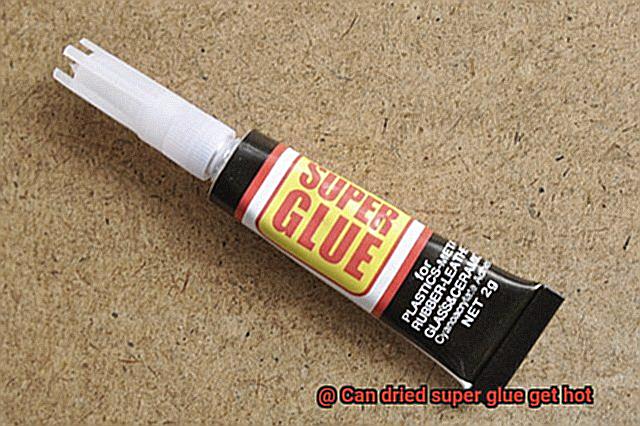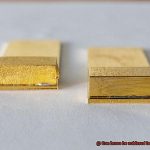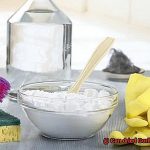Have you ever found yourself in a sticky situation where you needed to fix something with super glue, only to have it dry up unused? Now, imagine finding that same dried super glue in a place where the temperature is gradually rising. Will it get hot and cause harm?
Super glue is a household and workshop staple for its ability to instantly bond objects together. But what happens when it dries up unused? Does it still retain its properties, or does it become a ticking time bomb? In this blog post, we’ll dive into the topic of whether dried super glue can get hot and the science behind it.
We’ll explore the properties of super glue and how it reacts to different temperatures. We’ll also delve into the chemical composition of super glue and investigate whether it has any flammable properties. But most importantly, we’ll answer the question on everyone’s mind – can dried super glue get hot?
Whether you’re an avid DIY enthusiast or just someone curious about this topic, fear not. We’ve got you covered. So buckle up and prepare to find out if dried super glue can get hot and what precautions you can take to stay safe.
What is Super Glue?
Contents
- 1 What is Super Glue?
- 2 How Does Super Glue Work?
- 3 Can Dried Super Glue Get Hot?
- 4 What Factors Affect the Temperature of Dried Super Glue?
- 5 Types of Super Glue and Their Heat Resistance
- 6 Safety Precautions When Using Super Glue in High-Temperature Situations
- 7 Potential Hazards of Exposing Dried Super Glue to Heat
- 8 Alternatives to Using Super Glue in High-Temperature Applications
- 9 Conclusion
When you need a fast and strong adhesive, Super Glue is often the go-to choice. This versatile adhesive can form a bond to almost any surface, from metal and plastic to wood and ceramic. But what is Super Glue, and how does it work?
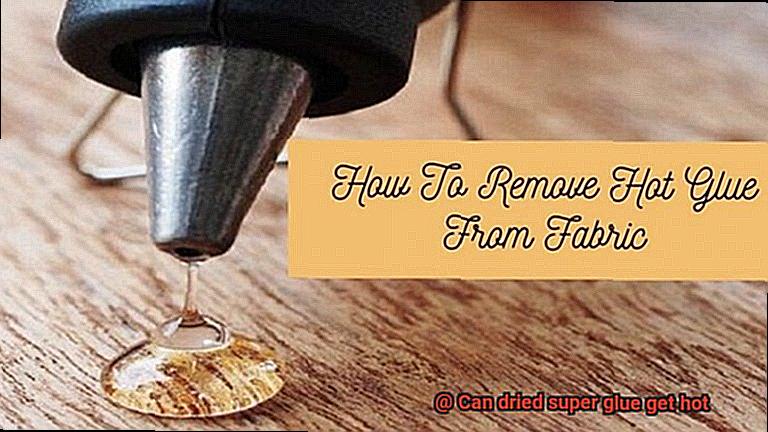
Super Glue, also known as cyanoacrylate adhesive, was discovered by Dr. Harry Coover in 1942 while he was trying to create clear plastic gun sights for the military. It’s made of ethyl cyanoacrylate and is known for its quick-drying capabilities and strong bonding properties.
The secret behind Super Glue’s effectiveness is its ability to react with moisture in the air or on the surface being bonded. This reaction causes it to harden quickly and form a strong bond. During the bonding process, heat may be generated, which can sometimes be felt. However, once the glue has hardened, it should not generate any additional heat unless exposed to high temperatures or other external factors.
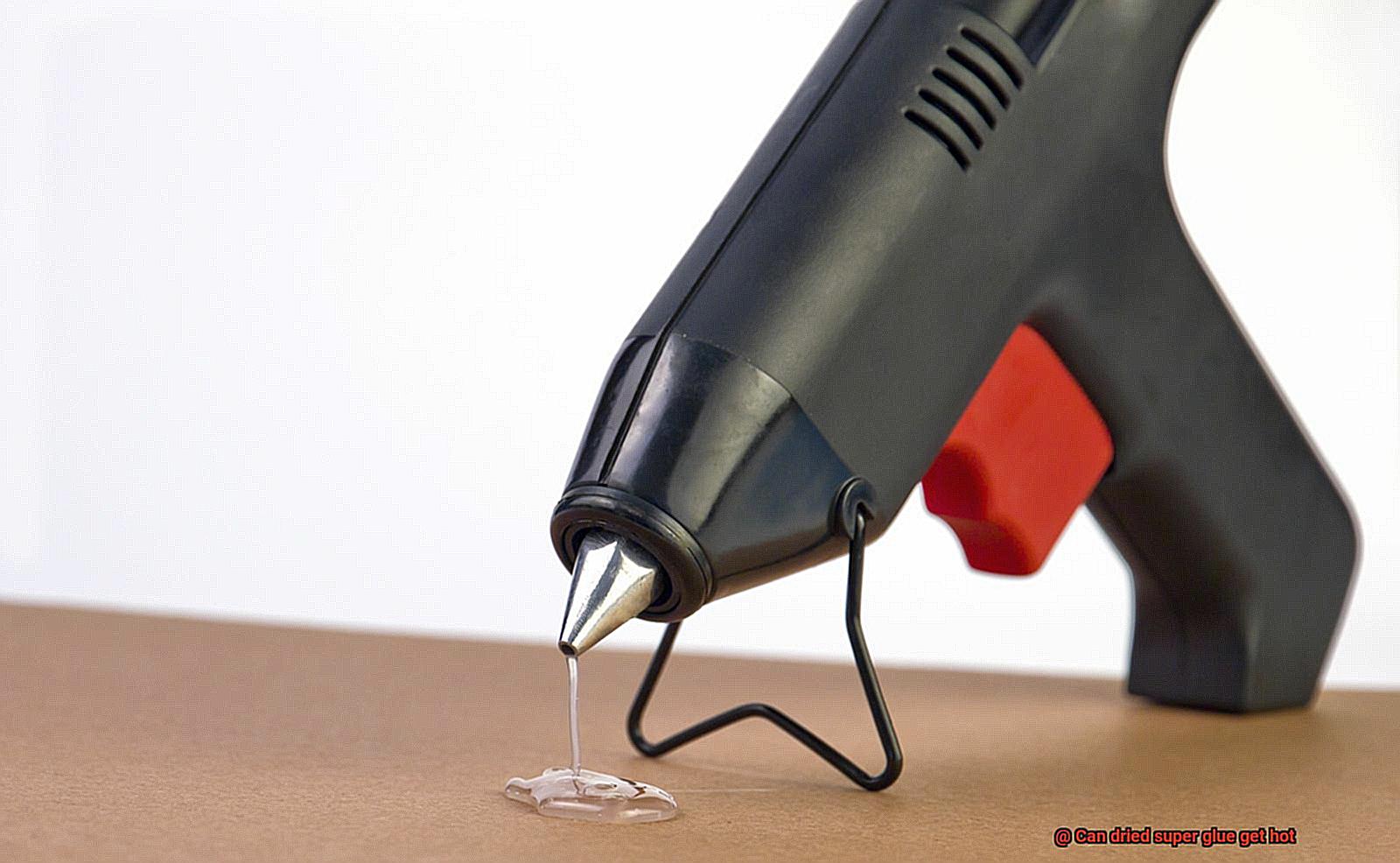
It’s important to note that not all Super Glues are created equal. Some formulas are more resistant to heat than others and may even be designed specifically for high-temperature applications. Before using Super Glue in any situation where heat may be a factor, it’s essential to read the manufacturer’s instructions and ensure that the product is suitable for the intended use.
While Super Glue is a highly effective adhesive, it should be used with caution. It can bond skin and other body parts together, causing injury if not handled properly. Additionally, it can release fumes that may be harmful if inhaled or ingested. To avoid these risks, it’s recommended to use gloves and protective eyewear when handling Super Glue and to avoid breathing in the fumes.
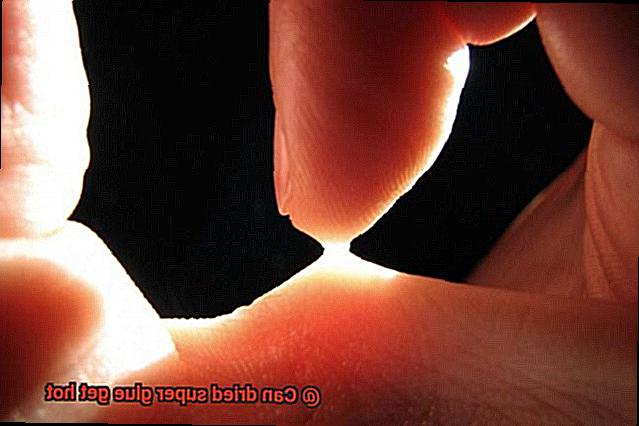
How Does Super Glue Work?
Super glue, also known as cyanoacrylate adhesive, is a fast-acting adhesive that can form a strong bond within seconds of application. This is because when it comes into contact with moisture, it undergoes an exothermic reaction that causes the glue to harden and form a strong bond. The secret behind its efficiency lies in this incredible chemical reaction.
At the heart of super glue is cyanoacrylate, a type of acrylic resin that plays a critical role in its bonding prowess. When this ingredient comes into contact with moisture, it polymerizes and hardens, generating heat that can sometimes make the surface of the glue feel warm to the touch. This extraordinary chemical reaction is what gives super glue its incredible bonding power.
While super glue can bond a variety of materials together effectively, it works best on smooth surfaces that fit together tightly, such as glass or metal. However, it may not work as well on porous materials like wood or fabric since these materials may absorb the glue before it has a chance to harden. Thus, it’s essential to choose the appropriate material for bonding and apply the right amount of glue to achieve optimal results.
It’s important to note that caution must be exercised when handling super glue as it can bond skin and release harmful fumes. Therefore, always handle it with care and use it in a well-ventilated area.
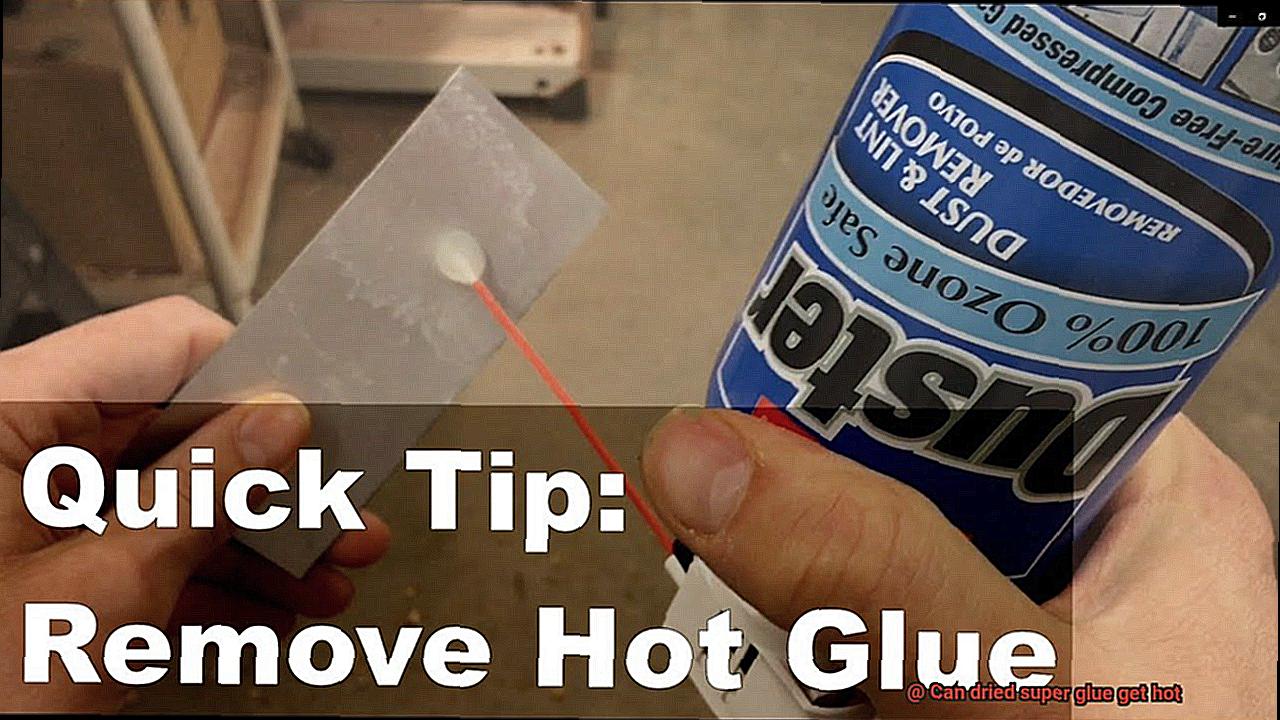
Can Dried Super Glue Get Hot?
As a seasoned adhesive expert, I assure you that this is a valid concern. So, let’s dive into the science behind why dried super glue can get hot and what safety precautions you should take when working with it.
To begin, let’s refresh our memory about super glue. This fast-drying adhesive uses a chemical reaction to bond materials together quickly, generating heat during the process. This means that the glue can become hot when applied. However, once it dries, it should not generate any more heat. Right? Not exactly.
Dried super glue can get hot under certain conditions. When exposed to high temperatures, the chemical properties of the glue can change, causing it to break down and release potentially harmful fumes. Additionally, if the dried super glue is exposed to direct heat or flames, it can catch fire and cause serious damage. This is why it is crucial to keep your dried super glue away from heat sources such as stoves, ovens, or heaters.
Now, let’s discuss whether all types of super glue can get hot. The answer is no; it depends on the specific type of glue and its composition. While some industrial-strength super glues are designed to withstand high temperatures and are used in extreme environments, most household super glues are not designed to withstand high temperatures and should be kept away from heat sources.
So what safety precautions should you take when working with dried super glue? Here are some tips:
- Always read and follow the manufacturer’s instructions when using any type of adhesive.
- Do not use super glue near heat sources or open flames.
- Wear gloves if you need to handle dried super glue, especially if you have sensitive skin.
- If you accidentally get super glue on your skin or eyes, seek medical attention immediately.
- Store your super glue in a cool, dry place away from heat and sunlight.
What Factors Affect the Temperature of Dried Super Glue?
As our research notes have shown, the temperature generated during the drying process can vary depending on a multitude of factors. Firstly, the amount and thickness of the glue applied can make a significant difference, with thicker layers generating more heat than thinner ones. So, when tackling bigger projects, be mindful that the heat generated may be intense.
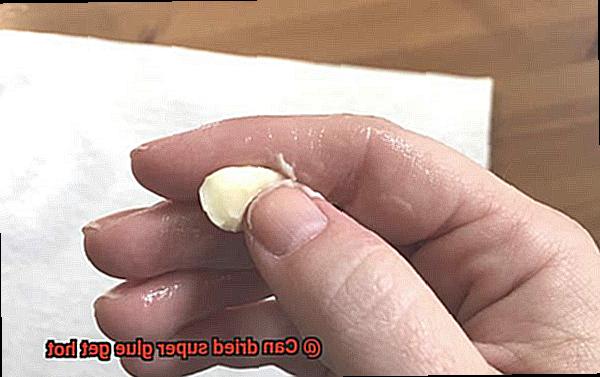
Secondly, environmental conditions play a crucial role in determining the temperature generated. Higher temperatures or exposure to direct sunlight can intensify the heat produced during the drying process. On the other hand, cooler and shaded areas can result in lower temperatures. Moreover, humidity levels can also influence how much heat is generated while drying.
Thirdly, the type of surface that super glue is applied to can also affect the temperature produced during drying. Non-porous surfaces like glass or metal don’t absorb as much heat as porous surfaces like wood or fabric. Additionally, the composition of the surface in question plays a role in determining how much heat is generated.
Lastly, different formulations of super glue can generate varying amounts of heat during the drying process. Some types contain chemicals that accelerate drying and generate more heat as a result. Conversely, others are formulated to dry more slowly, which reduces the amount of heat generated.
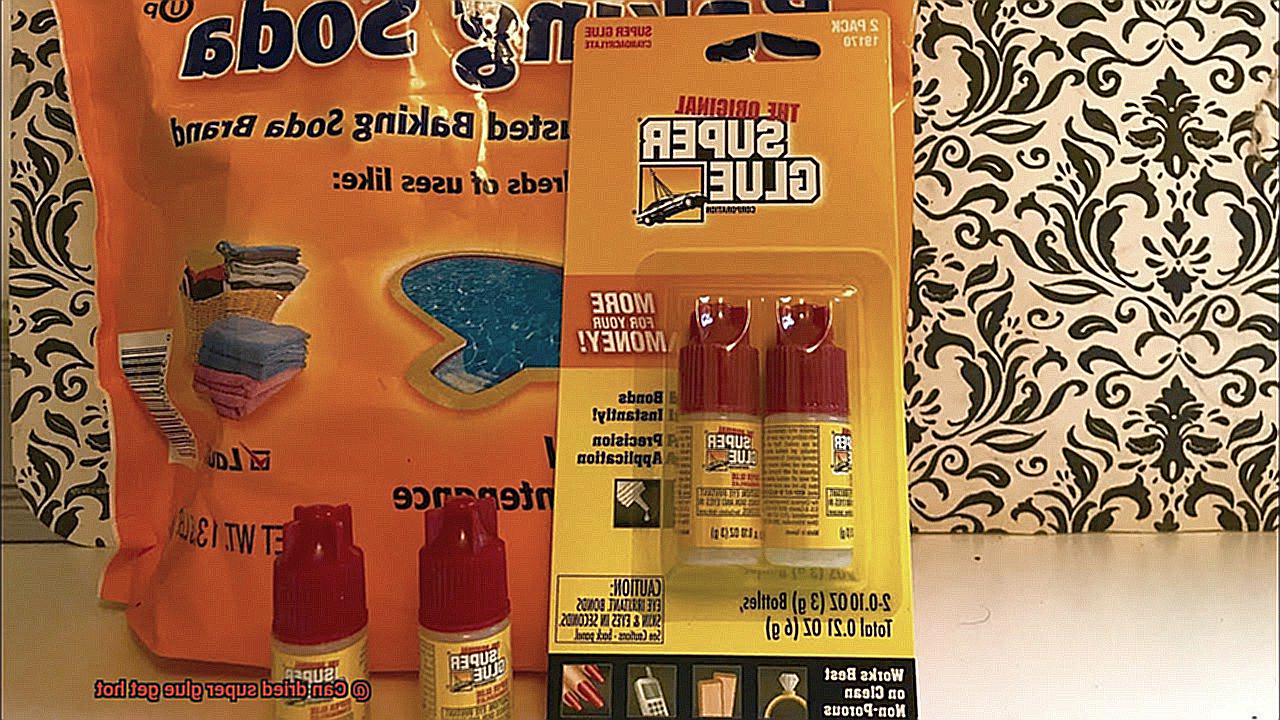
In conclusion, there are several factors to consider when it comes to understanding how much heat dried super glue can generate. The thickness and amount of glue applied, environmental conditions, surface type and composition, and formulation all play a part. It’s essential to practice safety measures when handling super glue and have an awareness of any potential risks associated with its use.
Types of Super Glue and Their Heat Resistance
Super glue, also known as cyanoacrylate adhesive, has become a popular choice for bonding materials together quickly and easily.
However, not all types of super glue are created equal, especially when it comes to heat resistance. Let’s explore the different types of super glue and their respective heat resistance capabilities in more detail.
Ethyl Cyanoacrylate
Ethyl cyanoacrylate is the most commonly used type of super glue and is ideal for general household repairs. However, its low heat resistance makes it unsuitable for high-temperature applications. Ethyl cyanoacrylate can only withstand temperatures up to 180°F (82°C), so it’s best to avoid using it in situations where high temperatures are involved.
Methyl Cyanoacrylate
Methyl cyanoacrylate is more flexible than ethyl cyanoacrylate and is commonly used for bonding wood and plastic. It has a higher heat resistance rating than ethyl cyanoacrylate and can handle temperatures up to 200°F (93°C). While this makes it a better option for high-temperature applications, it’s still not suitable for extreme high-temperature environments.
Butyl Cyanoacrylate
Butyl cyanoacrylate is the least common type of super glue and is often used in medical applications due to its high biocompatibility. It has the highest heat resistance rating among the three types of super glue, making it suitable for use in moderate high-temperature environments. Butyl cyanoacrylate can withstand temperatures up to 250°F (121°C).
Epoxy-Based Super Glues

Epoxy-based super glues are a better choice for high-temperature applications due to their excellent heat resistance capabilities. They can withstand temperatures of up to 300°F (149°C) or more, depending on the specific type of epoxy used. This makes them ideal for use in industrial settings where high temperatures are common.
Silicone-Based Super Glues
Silicone-based super glues have excellent heat resistance and can withstand temperatures of up to 600°F (316°C) or more, making them the best option for extreme high-temperature environments. This makes them ideal for use in automotive and aerospace applications where high temperatures are a common occurrence.
Safety Precautions When Using Super Glue in High-Temperature Situations
It’s essential to exercise caution and take safety precautions when using super glue in high-temperature situations.
The first and most important precaution to take is to ensure that the materials being bonded can withstand the heat. If they can’t, then using super glue may not be the best option. Also, avoid using super glue on surfaces that will be exposed to high temperatures, as this can lead to the glue breaking down and potentially causing damage or harm.
When working with super glue in high-temperature situations, it’s crucial to wear protective gear such as gloves and eye protection. This is because super glue can release fumes that can irritate the skin, eyes, and respiratory system. Wearing protective gear can prevent any potential harm or irritation caused by the fumes.
In addition, it’s important to use super glue in a well-ventilated area and avoid inhaling its fumes. You can achieve this by working in a room with open windows or doors, or by using a ventilation system such as a fan or extractor hood.
It’s also important to note that accidental ingestion or skin contact with super glue can cause harm. If this occurs, seek medical attention immediately. Super glue can cause harm if ingested or left on the skin for too long. Therefore, it’s best to be cautious and seek help if needed.
Potential Hazards of Exposing Dried Super Glue to Heat
It’s fast-acting and can bond almost anything together in a snap. However, caution is essential when using it in high-temperature situations as exposing dried super glue to heat can have potential hazards that should not be ignored.
Firstly, when heated, super glue can release toxic fumes that can cause irritation to the eyes, nose, and throat. These fumes may lead to respiratory problems and even asthma attacks in some individuals. Therefore, if you’re planning to use super glue in a hot area or near a heat source, ensure that you’re wearing protective gear and working in a well-ventilated area.
Secondly, when dried super glue is exposed to heat, it can change its chemical properties and become unstable. This instability can cause the glue to break down or lose its adhesive properties, making it ineffective for future use. So, if you want to ensure the longevity of your project and avoid any mishaps, avoid exposing dried super glue to heat.
Moreover, if the heat source is strong enough, it can cause the dried super glue to ignite and catch fire. This could pose a serious safety risk if not handled properly. Therefore, never expose dried super glue to an open flame or any other heat source that is strong enough to cause ignition.
It’s worth noting that different types of super glue may react differently to heat. Therefore, it’s critical always to refer to the manufacturer’s instructions and warning labels before exposing it to any type of heat source. In summary, it’s best to avoid exposing dried super glue to heat whenever possible to prevent any potential hazards or risks. Remember: safety first.
Alternatives to Using Super Glue in High-Temperature Applications
Worry no more. There are numerous alternatives available that can provide a strong and durable bond without any added risks.
One of the most popular options is epoxy-based adhesives. These adhesives are formulated specifically to resist high temperatures and can bond a wide range of materials with ease. Whether you’re working on a DIY project or fixing a broken item, epoxy-based adhesives offer a reliable solution that won’t disappoint.
If you’re looking for an adhesive that’s perfect for the automotive or aerospace industries, silicone-based adhesives are an excellent choice. They are highly resistant to heat and chemicals and offer strong bonding capabilities even in harsh conditions.
For those who prefer mechanical fastening methods, bolts, screws, and rivets can also be used in high-temperature applications. These methods provide a secure and reliable bond that can withstand extreme temperatures without any added safety risks.
When selecting an adhesive or mechanical fastening method for high-temperature applications, it’s essential to consider factors such as the specific temperature range and the strength required. By choosing the right solution, you can ensure a strong and reliable bond that will stand the test of time.
Conclusion
In conclusion, dried super glue can certainly heat up under specific circumstances. While the adhesive generates heat during the bonding process, it should not produce any additional warmth once it has solidified unless exposed to high temperatures or other external factors. It is vital to keep dried super glue away from heat sources such as stoves, ovens, or heaters, as direct exposure to flames or heat can result in it catching fire and causing significant damage.
It is worth noting that not all types of super glue are created equal concerning heat resistance. Ethyl cyanoacrylate is commonly used for general household repairs but has low heat resistance and can only tolerate temperatures up to 180°F (82°C). On the other hand, silicone-based super glues have excellent heat resistance and can endure temperatures of up to 600°F (316°C) or more.
When dealing with super glue in high-temperature situations, it is essential to wear protective gear such as gloves and eye protection and work in a well-ventilated area. Alternatives such as epoxy-based adhesives, silicone-based adhesives, bolts, screws, and rivets provide reliable solutions for high-temperature applications without added safety risks.
By comprehending the properties of super glue and taking necessary precautions when working with it in high-temperature situations, we can guarantee safe and effective use of this potent bonding agent.

